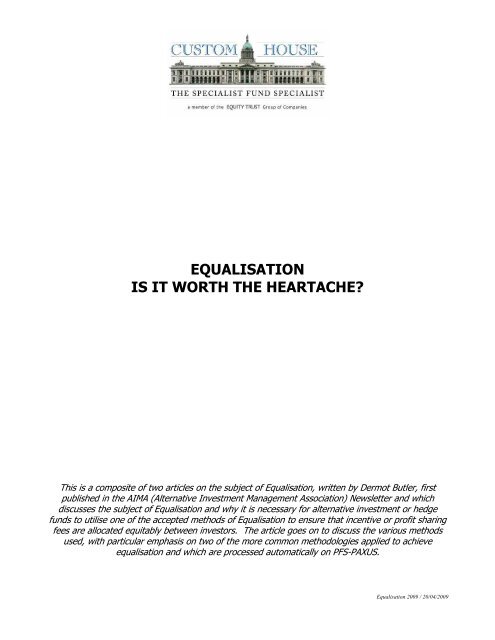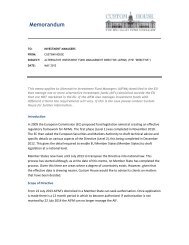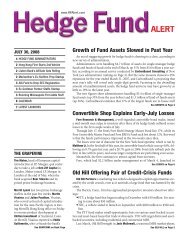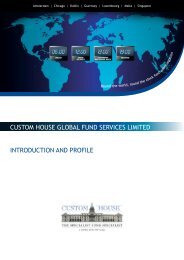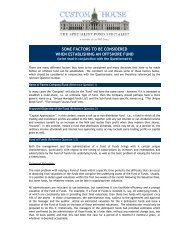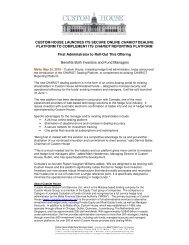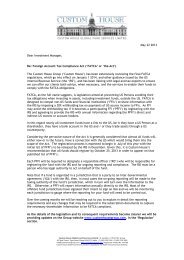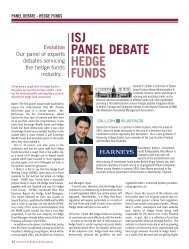EQUALISATION IS IT WORTH THE HEARTACHE? - Custom House
EQUALISATION IS IT WORTH THE HEARTACHE? - Custom House
EQUALISATION IS IT WORTH THE HEARTACHE? - Custom House
You also want an ePaper? Increase the reach of your titles
YUMPU automatically turns print PDFs into web optimized ePapers that Google loves.
<strong>EQUAL<strong>IS</strong>ATION</strong><br />
<strong>IS</strong> <strong>IT</strong> <strong>WORTH</strong> <strong>THE</strong> <strong>HEARTACHE</strong>?<br />
This is a composite of two articles on the subject of Equalisation, written by Dermot Butler, first<br />
published in the AIMA (Alternative Investment Management Association) Newsletter and which<br />
discusses the subject of Equalisation and why it is necessary for alternative investment or hedge<br />
funds to utilise one of the accepted methods of Equalisation to ensure that incentive or profit sharing<br />
fees are allocated equitably between investors. The article goes on to discuss the various methods<br />
used, with particular emphasis on two of the more common methodologies applied to achieve<br />
equalisation and which are processed automatically on PFS-PAXUS.<br />
Equalisation 2009 / 20/04/2009
I have seen the mere mention of the subject of “Equalisation” cause the eyes of the most sophisticated fund<br />
accountants to acquire the glazed, almost frightened, look of someone who has just seen “The Exorcist”.<br />
What is Equalisation and why does it cause these problems?<br />
In the context of alternative investment and hedge funds – indeed any open ended fund that pays incentive or<br />
performance fees – “Equalisation” means an accounting methodology, designed to ensure that not only the<br />
investment manager is paid the correct incentive fee, but also that the incentive fees are fairly allocated between<br />
each investor in the fund.<br />
Why is this a problem? The easiest way to answer this is by way of examples:<br />
The Free Ride<br />
Firstly the famous “free ride”, which was the original reason and justification for the introduction of<br />
Equalisation in the first place. This example, which is illustrated in Table 1, assumes that a fund starts trading at<br />
US$100 per share and that there is an initial investor – Investor A – who buys one share at US$100. Let is now<br />
assume that, at the end of the first quarter, the gross NAV per share has risen to US$110. This will result in an<br />
NAV per share of US$108, net of the incentive fee of US$2 (20% of the US$10 profit), which has been paid.<br />
Let us now assume that one month later the NAV per share has fallen to US$100 again and a second investor –<br />
Investor B – comes in and buys one share for US$100. Without one of the Equalisation methods being applied,<br />
the fund manager would not be able to charge any incentive fees on this second investors subscription until the<br />
NAV per share had risen back up to US$110 and if that happens, Investor B will get a “free ride” of US$2 per<br />
share, being the incentive fee that he will not be paying on his profit of US$10 per share.<br />
Equalisation will eliminate this anomaly.<br />
TABLE 1 - <strong>THE</strong> “FREE RIDE”<br />
i) Investor A buys one Share at US$100.<br />
ii) End of first quarter Gross NAV per Share has risen to US$110.<br />
iii) NAV per Share published at US$108 – (US$110 – US$2 incentive fee).<br />
iv) New High Watermark – US$110.<br />
v) At end of the following month, the NAV per Share falls to US$100.<br />
vi) Investor B buys one Share at US$100.<br />
vii) High watermark still US$110.<br />
viii) If NAV per Share rises to US$110 again, Investor B will have a US$2 (20% of US$10<br />
profit) “Free Ride”.<br />
Rising Share Price<br />
There are those who believe that the “free ride” is the sole justification for Equalisation, but this is not true. It is<br />
a fact that without some form of Equalisation being applied when investors subscribe at different NAV levels,<br />
one shareholder will always be subsidising another shareholder, to some extent or another even with consistently<br />
rising NAVs. See the example shown in Table 2, where again we assume that Investor A buys one share at<br />
US$100 when it is launched. We again assume the market rises, but this time by the end of the second month,<br />
to US$110 NAV per share. The NAV per share is published at US$108, net of the 20% incentive fee accrual.<br />
Investor B now buys one share at US$108, being the published NAV. Let us now assume that at the quarter end<br />
the gross NAV per share has in fact risen to US$120. This results in gross profits of US$32 based on the<br />
following calculation:<br />
2
Investor A invested US$100 and Investor B invested US$108, for a total sum invested of US$208.The gross<br />
NAV of the fund at the end of the quarter was US$240 (2 x shares at US$120). This represents a gross profit of<br />
US$32 over the total sum invested of US$208.<br />
To be equitable the profits should be allocated as US$20 to Investor A and US$12 to Investor B. However let us<br />
look at how the incentive fee, which will now be due, will be calculated.<br />
The incentive fee should be 20% of the gross profit of US$32, which is US$6.40, or US$3.20 per share. Thus<br />
the gross NAV of US$240 less the incentive fee of US$6.40 result in a net NAV of US$233.60, or US$116.80<br />
per share.<br />
What does this mean? It means that Investor A has effectively paid US$3.2 incentive fee on a profit of US$20,<br />
which equates to 16.4% of Investor A’s profit, whereas Investor B, who also effectively pays US$3.20 incentive<br />
fee, but does so on a profit of US$12, which equates to an incentive fee of 26.66% of Investor B’s profit. This is<br />
obviously inequitable.<br />
Equalisation will eliminate this anomaly.<br />
TABLE 2 - R<strong>IS</strong>ING SHARE PRICE<br />
i) Investor A buys one Share at US$100.<br />
ii) NAV per Share rises in the second month to US$110.<br />
iii) NAV per Share published at US$108, net of 20% incentive fee accrual.<br />
iv) Investor B buys one share at US$108.<br />
v) At quarter-end, the Gross NAV per Share has risen to US$120.<br />
vi) Gross profit is US$32, calculated as follows:<br />
a) Investor A invested: US$100<br />
b) Investor B invested: US$108<br />
Total invested:<br />
US$208<br />
c) Gross NAV at end Qt: US$240<br />
Gross Profit: US$ 32<br />
vii) Incentive fee at 20% of US$32 = US$6.4 Gross, or US$3.2 per Share.<br />
viii) NAV per Share = (US$240 ÷ 2) = (US$120 – US$3.2 incentive fee) = US$116.8 per Share.<br />
ix) Therefore:<br />
a) Investor A effectively pays US$3.2 incentive fee on a profit of US$20, which equals<br />
16.4% of the profit made by Investor A; whereas<br />
b) Investor B effectively pays US$3.2 incentive fee on a profit of US$12, which equals<br />
26.66% of the profit made by Investor B.<br />
The Claw Back Syndrome<br />
And of course Equalisation is also necessary to avoid what is known as the “claw-back” syndrome. This occurs<br />
where, following in the initial rise to US$110 shown in the second example given above but the price back to<br />
say US$96 at the end of the quarter and does not rise to US$120 as shown in Table 3 below.<br />
The incentive fee accrual made at the end of the second month following the successful trading would now<br />
revert back to the fund but, without Equalisation, that accrual would benefit all shareholders, including the new<br />
investor, whereas the original incentive fee accrual was only accrued in respect of Investor A’s investment and<br />
not Investor B’s investment.<br />
Remember, the total value of the fund at the end of the second month is in fact US$218, even though the NAV<br />
was published at US$216 (US$108 per share), because the US$2.00 incentive fee had only been accrued, it had<br />
not been paid out. Because in the following month the fund declined and lost US$26, the NAV of the fund<br />
declined from US$218 to US$192. Thus, the NAV per share at the end of the quarter was US$96. However, as<br />
3
the fund had lost US$26 the equitable allocation would have been to debit US$13 to each investor’s account.<br />
Thus Investor A, whose account was worth US$110 at the end of the second month, before accruing the<br />
incentive fee, would have declined by US$13 to US$97. Whereas Investor B, who only subscribed US$108 and<br />
the end of the second month, should also have seen his NAV per share decline by US$13 to US$95. As stated<br />
above, the incentive fee accrual of US$2, which was applied at the end of the second month, related to<br />
unrealised gains on Investor A’s account. Because this has been “clawed back” by the fund as a whole, it has<br />
been allocated to shareholders on a pro-rata basis. Thus, without equalisation, the value of Investor A’s holding<br />
has dropped from US$97 to US$96, whereas Investor B benefits from an allocation from part of Investor A’s<br />
incentive fee accrual, to the value of US$1, so that the NAV per share of his investment is now US$96 instead<br />
of US$95.<br />
Equalisation will eliminate this anomaly.<br />
TABLE 3 - “CLAW BACK” SYNDROME<br />
i) Investor A buys on Share at US$100 per share at launch.<br />
ii) At the end of the second month the Gross NAV per share has risen to US$110, i.e. US$108<br />
net of incentive fee accrual.<br />
iii) Investor B now buys one share at US$108.<br />
iv) The NAV of the fund is now US$218 excluding incentive fee accrual.<br />
v) The fund loses US$26 in month three. The Gross NAV falls down to US$192 or US$96 per<br />
share.<br />
vi) The loss per share should be US$26 ÷ 2, which equals US$13 per share.<br />
vii) Given that the fund lost US$13 per share, the fair value of Investor A’s investment should be<br />
US$97 (US$110 – US$13) whereas the fair value for Investor B should be US$95 (US$108<br />
less US$13)<br />
viii) The actual loss to Investor A is US$14 (US$110 less US$96), whereas the loss to Investor B<br />
is only US$12 (US$108 invested less US$96).<br />
How is Equalisation achieved and how are these anomalies eliminated?<br />
Before discussing Equalisation methods, I must say that it is surprising how many alternative investment and<br />
hedge funds still operate without applying any form of Equalisation. This is mainly done in order to avoid the<br />
complications, hassle and heartache involved in applying one of the Equalisation methodologies to a fund’s<br />
accounts. All of the systems are to a greater or lesser extent investor “unfriendly” and, frankly some investors,<br />
not only have great difficulty in understanding it, but often have great difficulty in not assuming that there is a<br />
“fiddle” going on. Having said that, I think it is clear that Equalisation is necessary, not just to ensure that the<br />
Investment Manager takes home every crust he earns, but to ensure that those incentive fees, when paid, are<br />
equitably distributed between shareholders. It is not right (and cannot be right) that, in order to avoid a<br />
complicated accounting procedure, one investor should be penalised to the advantage of another investor.<br />
As I have mentioned above, the Equalisation process is an accounting methodology which enables each<br />
individual investor, or group of investors, who invest in a fund at the same time to be individually assessed for<br />
their own incentive fee liability and charged accordingly. If this can be achieved, this will eliminate the problem<br />
of one investor being penalised to the advantage of another.<br />
There are several different Equalisation Methodologies used. These include the Series of Shares and<br />
Consolidation Method and a number of different “Equalisation Methods”.<br />
4
Series of Shares and Consolidation Method<br />
This is, in my opinion, the most user-friendly and simplest of the Equalisation Methods. It requires the fund to<br />
issue a new Series of Shares (“Series”) each time there is a subscription. Every month, when calculating the<br />
NAV per Share, the correct incentive fee accruals, if any, are applied to each of the Series separately. The first<br />
Series of Shares, which are issued when the fund is launched, is usually known as the “Lead Series”. The<br />
objective is to consolidate each of the subsequent Series issued into the Lead Series, at the end of every<br />
accounting period, providing an incentive fee has been paid for each of the Series, including the Lead Series.<br />
This may be quarterly, half-yearly, or annually.<br />
How does it Work?<br />
By way of example (see Table 4), let us assume that Investor A purchases 1,000 Shares at the launch of the<br />
fund, at US$1,000 per Share. This will be the “Lead Series” of Shares. (For this example we are assuming that<br />
the incentive fees are being paid quarterly).<br />
Let us then assume that at the end of the first month the Gross NAV (“GNAV”) (the NAV before deduction of<br />
incentive fee) per Lead Share has risen to US$1,100 and therefore the NAV will be US$1,080, net of US$20 /<br />
20% incentive fee. At this time Investor B subscribes US$1 million for 1,000 Series II Shares at, again<br />
US$1,000 each.<br />
At the end of the second month, the value of the fund has risen by a further 10%, so that GNAV for the Lead<br />
Series is now US$1,210, whereas the GNAV for Series II is now US$1,100. The NAVs for the Lead Series will<br />
now be US$1,168 and, for Series II US$1,080, net of 20% incentive fee accrual. At this stage Investor C<br />
subscribes a further US$1 million for 1,000 Shares of Series III at US$1,000 per Share.<br />
Let us now assume that, at the end of the third month, the NAV has yet again risen by a further 10%, so that:<br />
a) The GNAV per Share of the Lead Series is US$1,331, which translates to an NAV of US$1, 264.80;<br />
b) The GNAV of Series II is US$1,210, equalling an NAV of US$1,168; and<br />
c) The GNAV for Series III is US$1,100, equalling an NAV of US$1,080.<br />
Thus, at the end of the first quarter and because a new High Water-Mark (“HWM”) has been reached and each<br />
of the Series of Shares have paid incentive fees, the Series II and Series III Shares can now be consolidated into<br />
the Lead Series. This means that, in effect, the owners of Series II and Series III Shares will sell, or exchange<br />
their Shares for Lead Series Shares. Therefore, Investor B’s Shares are worth US$1,168.00, which equates to<br />
923.46616 Shares at the NAV per Lead Series, at US$1,264.80 each. Similarly Investor C will effectively<br />
liquidate his 1,000 Shares for US$1,080,000 and effectively invest those proceeds of that liquidation into the<br />
Lead Series at US$1,264.80 per Share, to receive 853.890 Lead Series Shares.<br />
If at the end of the third month the value of the fund has declined by say 4%, then the Lead Series and Series II<br />
would still be profitable and could be consolidated. However, the Series III would be showing a loss, at GNAV<br />
of US$960 and so would not be consolidated. The Series III would remain in existence until a new HWM had<br />
been achieved, which would put the Series III into profit.<br />
5
TABLE 4 – “SERIES OF SHARES AND CONSOLIDATION METHOD”<br />
i) Investor A buys 1,000 Lead Series Shares at US$1,000 per Share<br />
ii) End of first month, GNAV per Share has risen 10% to US$1,100<br />
iii) NAV published at US$1,080 (US$1,100 less US$20 incentive fee)<br />
iv) Investor B now buys 1,000 Series II Shares at US$1,000 per Share<br />
v) End of second month, value of fund has risen by further 10% so that:<br />
(a) GNAV of Lead Series is now US$1,310 = NAV US$1,168; and<br />
(b) GNAV of Series II is now US$1,100 = NAV US$1,080<br />
vi) Investor C buys 1,000 Series III Shares at US$1,000 per Share<br />
vii) End of third month, fund value has again risen by 10%, so that:<br />
(a) GNAV of Lead Series is now US$1,331 = NAV US$1,264.80;<br />
(b) GANV of Series II is now US$1,210 = NAV US$1,168; and<br />
(c) GNAV of Series III is US$1,100 = NAV US$1,080<br />
viii) As it is the end of the quarter and new HWM has been achieved, the incentive fees are paid.<br />
ix) Series II and Series III Shares are then consolidated into Lead Series<br />
x) Thus:<br />
(a) Investor B exchanges 1,000 Series II Shares, now worth US$1,168,000, for<br />
923.466 Lead Series Shares, at US$1,264.80; and<br />
(b) Investor C exchanges 1,000 Series III Shares, now worth US$1,080,000, for<br />
853.890 Lead Series Shares<br />
The advantage of this system is that it is a relatively simple Method and, investors can understand how it works<br />
and can see that it is fair to all parties.<br />
One of the disadvantages of this approach, however, is the fact that many funds only pay incentive fees once a<br />
year and this means that the Series of Shares and Consolidation Method can be quite cumbersome, because, if a<br />
fund is a heavily traded, expanding fund, then by the end of the year it could have twelve separate Series in<br />
issue. And of course, if it is a losing year, then it is possible that that could go up to twenty-four Series being<br />
issued, before the next accounting period is finished.<br />
The other obvious disadvantage of the Series Method is that it is not possible to publish a single NAV per Share,<br />
because each Series had its own NAV. Of course, there is no real problem in publishing several different<br />
NAVs, but it could be confusing to some shareholders, particularly if they make several investments into the<br />
fund over a period of time and so end up with holdings that have different NAVs. The third main drawback of<br />
issuing several Series of Shares occurs with fund’s whose Shares are listed on the Irish Stock Exchange, because<br />
it will be necessary to apply to list each Share in issue. This is administratively time consuming and therefore<br />
expensive and again there is the problem of having to publish the full list of NAVs.<br />
US Partnerships<br />
I would point out that this Equalisation problem does not generally occur in the United States, because most, if<br />
not all, US Alternative Investments and Hedge Funds are structured as Partnerships, primarily for tax reasons.<br />
Therefore, because Partnership books are kept on a capital accounting basis, these Equalisation problems just do<br />
not occur. Of course the Series of Shares Method, in effect, replicates the relevant components of partnership<br />
accounting at a corporate level. US investors need to have full tax transparency in order to comply with US tax<br />
reporting requirements and, ironically, it is largely because of this tax transparency that offshore investors tend<br />
to shy away from Partnerships, because they do not wish to have a tax liability occur on an annual basis, but<br />
only when they liquidate their holdings.<br />
6
Equalisation Accounting Methodology<br />
Equalisation Methods are a very much more complex way of achieving the same result as the Series of Shares<br />
Method, but with the advantage of producing one NAV per Share.<br />
The Wish List<br />
As I mentioned above, there are several different variations on the Equalisation Method, the objective of all of<br />
which (including the Series Method) is to try and ensure:<br />
i) the equitable allocation of incentive fees between each investor in a fund, to ensure that the<br />
Investment Manager is paid the correct amount and that each investor pays the amount that it should<br />
be paying and is not subsidized by, or does not subsidize, another investor;<br />
ii)<br />
iii)<br />
iv)<br />
that all investors have the same capital risk per Share;<br />
that there is a single NAV per Share;<br />
that the published NAV accurately reflects the fund’s performance; and<br />
v) finally that the Method used should be easily understood by all parties including the investors.<br />
It has to be said that nobody has yet produced a perfect Equalisation Method that meets all of these objectives<br />
and is unlikely to do so, until investors have been fully educated in this subject. As I have already said, it is, I<br />
think, reasonable to claim that the Series Method is easily understood by most investors, however the Series<br />
Method does not provide a single NAV. The other Equalisation Methods, which I describe below do provide a<br />
single NAV, but are not easily understood by most investors, although many more investors do understand these<br />
procedures than did a couple of years ago.<br />
Simple Equalisation<br />
The first of the more common Methods of Equalisation is what had been described as “Simple Equalisation”,<br />
which some might consider to be an oxymoron. Be that as it may, the procedure is to calculate the performance<br />
fee and allocate it fairly between each investor, or group of investors at the end of each accounting period. As<br />
investors will have come in at different levels this will mean calculating different NAVs per investor. However,<br />
in order to get a common NAV for all Shares in the fund, the lowest of all the NAV’s calculated, on an investor<br />
by investor basis, is selected to become the NAV of the fund.<br />
Shareholders with a higher individual NAV per Share are then issued “Equalisation Shares”, so that the total<br />
number of Shares issued to that investor (i.e.- the original Shares purchased plus any Equalisation Shares)<br />
multiplied by the new NAV of the fund, which we know is the lowest NAV calculated, will now enable the<br />
investment for those investors to be kept constant.<br />
The advantages of this system are that it is relatively simple to calculate the NAV for each shareholder and you<br />
end up with a single NAV per Share for the fund.<br />
However, there are two main disadvantages. Firstly, that the NAV does not accurately reflect the fund<br />
performance, because it is continually discounted and, secondly, the addition of Equalisation Shares to investors<br />
accounts, on what, to many probably seems an arbitrary basis, confuses those investors.<br />
7
Equalisation Factor / Depreciation Deposit Approach<br />
The most common Methods of Equalisation are the “Equalisation Factor / Depreciation Deposit Approach” and<br />
what is known as the “Equalisation Adjustment Approach”. They are both very similar.<br />
Under the Equalisation Factor / Depreciation Deposit Approach, each investor invests at the NAV, plus either<br />
the Equalisation Factor or the Depreciation Deposit, depending upon whether the NAV of the Fund has<br />
increased or declined from the last high water-mark.<br />
If the NAV has risen during the period, then a new subscriber would invest the equivalent of the GNAV, to<br />
place the same amount of money at risk as the existing shareholders, the difference between the NAV and the<br />
GNAV being the Equalisation Factor. If the fund maintains its performance, the Equalisation Factor paid will<br />
be refunded in Shares, at the end of the incentive fee calculation period. If, however, the fund subsequently<br />
loses value the Equalisation will be lost for that period, but is refundable, in the future, if the fund recovers.<br />
This avoids the claw-back syndrome.<br />
If, on the other hand, the fund’s NAV is at a discount to the high watermark at the time that an investor makes a<br />
subscription, then the investor will be required to pay a Depreciation Deposit. If the fund starts to improve and<br />
recoup its losses, then the Depreciation Deposit becomes payable to the Investment Advisor as a performance<br />
fee. This avoids the ‘free ride’ syndrome.<br />
Equalisation Adjustment Approach<br />
The Equalisation Adjustment Approach is similar to the Equalisation Factor / Depreciation Deposit Method, in<br />
that the investor will subscribe at the GNAV, but if the NAV at the time of subscription is above the previous<br />
high water-mark, then the investor will receive an Equalisation Credit for that portion of the NAV which<br />
represents the incentive fee accrual, (which the investor has paid within the GNAV). Like the Equalisation<br />
Factor, if, at the end of the accounting period the NAV is still showing a profit, or an increased profit, the<br />
investor will be paid his Equalisation Credit by way of an allocation of additional Shares in the fund. If the<br />
fund’s NAV declines after the purchase of the Shares, then the Equalisation Credit will decline pro rata, but is<br />
recoupable.<br />
Both the Equalisation Credit and Equalisation Factor Methods enable all of the investor’s money to be utilized<br />
in the fund.<br />
If the investor subscribes during a draw down, or loss, period, he will still pay the GNAV (which, in this case,<br />
will be the same as the NAV), so that he has the same amount of capital risk as existing shareholders, but he will<br />
also receive what is described as an “Equalisation Deficit”. If the fund subsequently increases in value by the<br />
end of the calculation period, a certain number of the investors Shares will be redeemed to equate to the<br />
Equalisation Deficit, (or that part of it that is applicable) and the proceeds paid into the Fund, as compensation<br />
to the other shareholders, in order to avoid that investor getting a “free ride”.<br />
The advantage of the Equalisation Deficit Method rather than the Equalisation Depreciation Deposit Method is<br />
that the investor’s money is fully invested in the fund, whereas under the Depreciation Deposit Method, the<br />
deposit is usually invested in T-Bills, Money Market Funds, or some other passive no-risk investment, which<br />
means that the investor is not getting full exposure to the fund.<br />
8
Equalisation Per Share Method<br />
Finally, there is the Equalisation Per Share Method, which we at <strong>Custom</strong> <strong>House</strong> have found to be the most<br />
popular method used by our clients.<br />
This method is no simpler or easier to understand than any of the other methods – in fact, its use of Equalisation<br />
deficits and credits is as complex as you could imagine. However, it is the flavour of the month and so rather<br />
than explain it in text within this document, we are attaching as Appendix 1, a copy of the text that we include in<br />
the Offering Memorandum of funds that use this methodology. You will see it also explains how the<br />
calculations are applied with the Hurdle Rate. The Appendix also includes a glossary of the terms used in the<br />
context of the Equalisation process, which we also include in Offering Memoranda, together with a numerical<br />
history of the transaction.<br />
Investment Management Agreement<br />
It is essential to ensure that the Equalisation method chosen complies with the Investment Management<br />
Agreement. Many, if not most, Investment Management Agreements state that the Investment Manager will be<br />
paid an incentive fee of 20% of profits. Thus, if a loss occurs, the Investment Manager has to recoup the total<br />
loss before any further incentive fees can be paid. What must be made clear is that, if an investor redeems<br />
during a draw down period and thereby accepts a portion of the loss, the amount of loss that the Investment<br />
Manager has to recoup will be reduced pro rata.<br />
Thus if a fund with four shareholders, who have subscribed US$1 million each, loses US$800,000, or 20% of<br />
the portfolio, and one shareholder redeems, thereby reducing the fund by a further US$800,000 (US$1 million<br />
less US$200,000 share of loss). There will now only be three shareholders left in the fund with the fund value<br />
standing at US$2.4 million. The Investment Management Agreement may require the Investment Manager to<br />
still earn back the full US$800,000 before he can earn any incentive fee, when in fact the remaining<br />
shareholders have only suffered a loss of US$600,000. Thus if the Investment Manager was required to earn<br />
back US$800,000 those shareholders would get a “free ride” on that US$200,000 profit.<br />
Choice<br />
The final problem as far as Equalisation goes is the choice of which Method is appropriate for a particular fund.<br />
This is usually dictated by a combination of market needs (for example, the choice as to whether to use the<br />
Series Method may be dictated by the fact that the Shares are listed on the Irish Stock Exchange) and, to a large<br />
extent, the Method that the Fund Manager is most comfortable with.<br />
Another factor that must be seriously considered is the ability of the chosen Administrator to calculate the NAV,<br />
utilizing the Equalisation Method selected. At this point I must declare a conflict of interest – a number of<br />
administrators, including my own company, have elected to utilize software that automates the Equalisation<br />
process. As a result the Administrator has had to make their own selection as to the process they deem most<br />
appropriate. With our system, <strong>Custom</strong> <strong>House</strong> is able to provide Equalisation on an automated basis, utilizing<br />
both the Series of Shares, the Equalisation Adjustment Approach and the Equalisation per Share Method, which<br />
is currently the most popular method, because we believe that they provide most of the components of the “wish<br />
list”, although none can be described as investor friendly, or easy to understand. But you can’t have everything!<br />
9
Dermot S. L. Butler is Chairman of <strong>Custom</strong> <strong>House</strong> Global Fund Services Limited, a member of the Equity Trust group of companies,<br />
which offers a full 24/5, “round the world” and “round the clock” administration service out of fully integrated offices in Chicago,<br />
Dublin, Guernsey, Luxembourg, Malta, Singapore and The Netherlands.<br />
For further information, please visit the <strong>Custom</strong> <strong>House</strong> website:<br />
www.customhousegroup.com<br />
or contact:<br />
Dermot S. L. Butler<br />
<strong>Custom</strong> <strong>House</strong> Global Fund Services Limited<br />
T: 353-1-878 0807<br />
e-mail: dermot.butler@customhousegroup.com<br />
<strong>Custom</strong> <strong>House</strong> Global Fund Services Limited is regulated by the Malta Financial Services Authority.<br />
10


